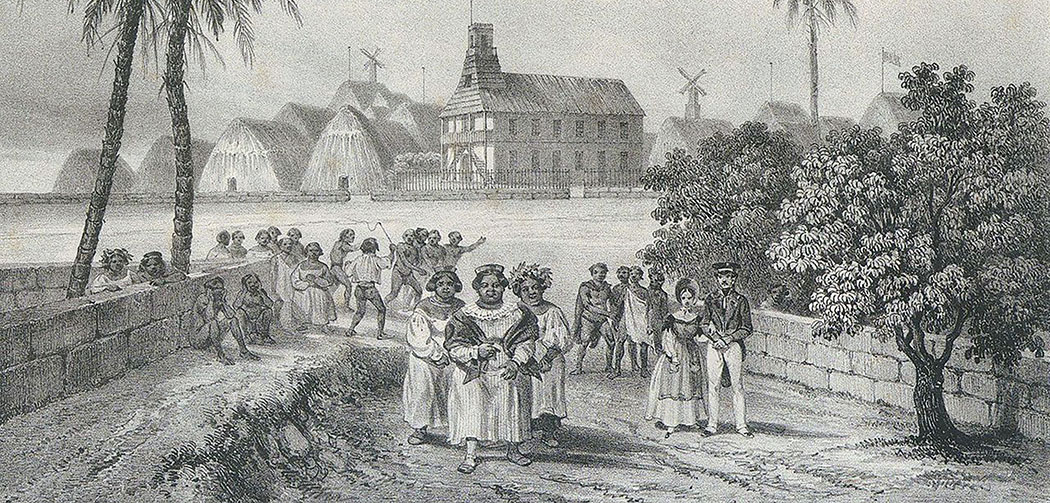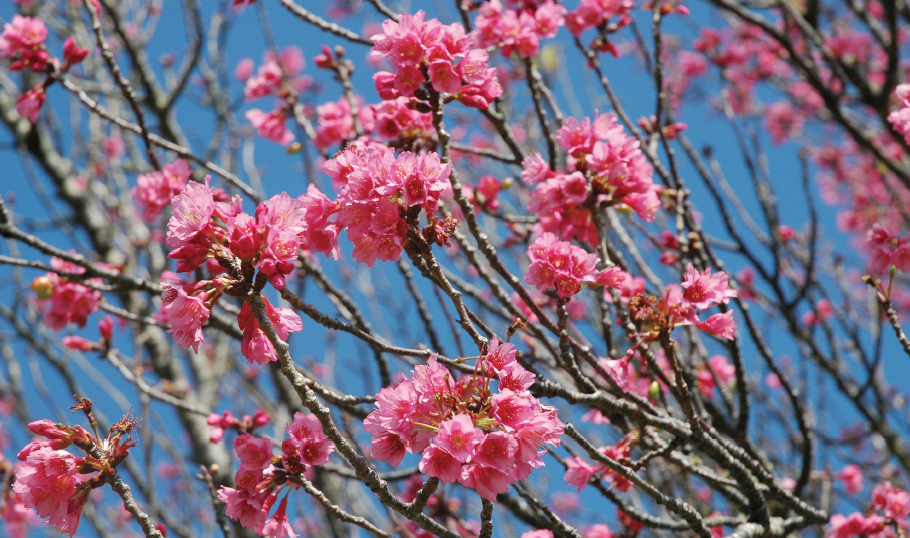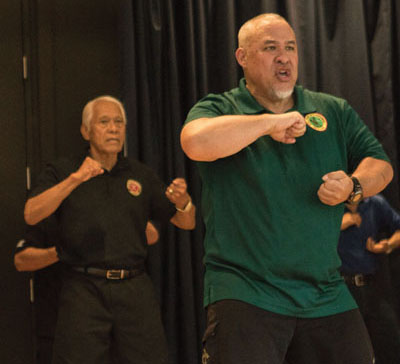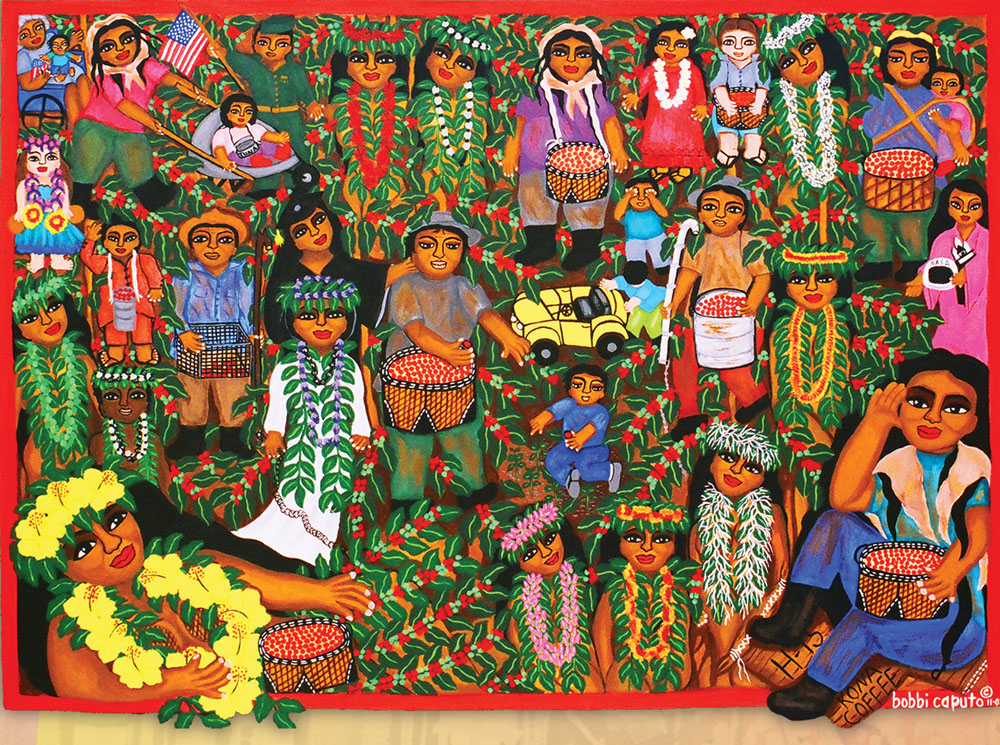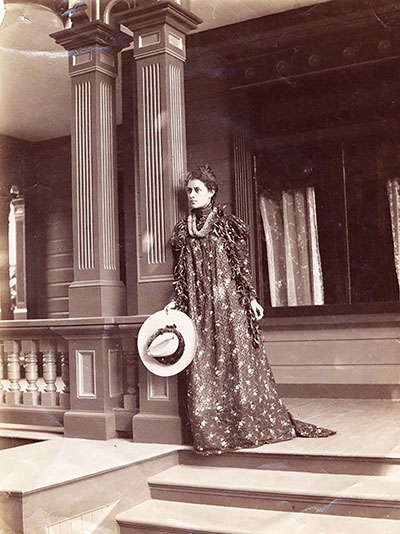
The Holokū
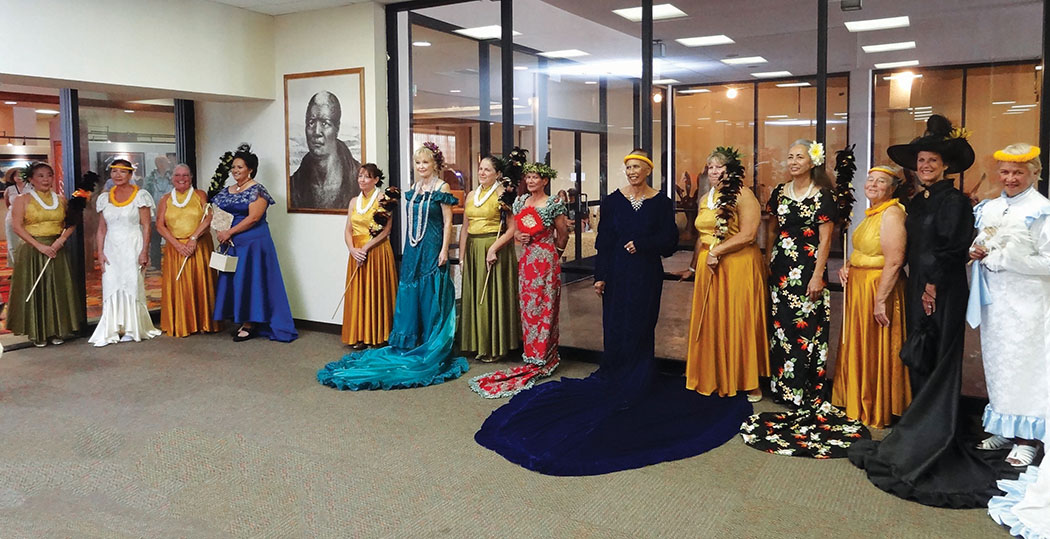
By Leilehua Yuen
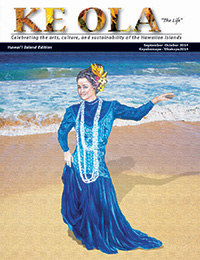
I remember as a girl longing for the day I would be deemed “a young lady,” mature enough to be allowed the privilege of wearing high heels, makeup, and that most elegant dress, the holokū. In our ‘ohana, our family, the favored style for this traditional gown was fitted, and so it required perfect posture that made the wearer look tall and stately. The long sweep of train demanded regal carriage so that the heavy fabric flowed gracefully across the floor as one walked, or danced the hula. I spent hours enduring correction to my stance, and walked endless miles up and down our stairs with a book balanced on my head, striving to achieve the effortless grace of movement that my grandmother and my aunt displayed.
I remember the awe with which I touched my first holokū. It was polished cotton. Velvet and satin were considered too “mature” for a girl in her early teens. It was from the designer Alfred Shaheen. Sky blue with a profusion of white night-blooming cereus, stamens drawn in metallic gold, tumbled from the ruffled shoulders and down the train. Not only was it a real holokū, but also it was cut deep in front and back, requiring an oh-so-grownup underwire foundation garment!
Hawaiian fashion begins long, long ago in the early mists of time and legend
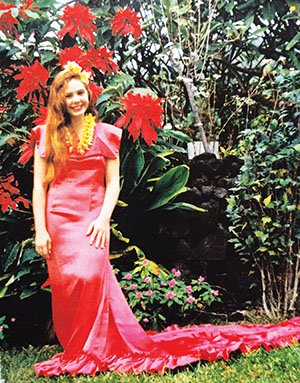
At one time, the people of Hawai‘i nei used leaves of mai‘a (banana), hala (pandanus) and kī (cordyline) to clothe themselves. At this time, a man named Maikoha lived in Nu‘uanu Valley at Pu‘iwa, beside the waters of a stream. Maikoha had two daughters, Lauhuiki and La‘ahana who were hard working and obedient. The three lived for many years, planting and farming beside the stream, catching river shrimps to eat with their vegetables, and trading with the neighbors when they wanted fish from the sea. Eventually Maikoha became old and knew he would soon die. He told his daughters to bury him beside the stream, and that soon after his burial a plant would grow from his body, and this plant would be useful to them. The young women followed his instructions, and soon a plant did grow. Their father came to them in dreams and taught them to strip the bark and pound it into large sheets, which could be fashioned conveniently into clothing and coverings. They learned to take the sap of plants and make beautifully colored dyes to decorate this new kind of garment. When others saw it, they asked what it was. “Ka pa!” The beaten thing. This new beaten thing could be worn in many ways, wrapped and twisted, gathered and ruffled, dyed different colors, and patterned beautifully. Fashion had come to Hawai‘i nei.
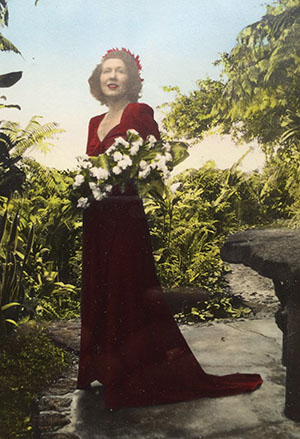
For hundreds of years, those of a sartorial bent delighted in finding new ways to decorate, pleat, fold, and tie their kapa. Pā‘ū (woman’s skirt) and kīkepa (tapa or sarong worn by women under one arm and over the shoulder of the opposite arm), malo (male’s loincloth), and kīhei (rectangular tapa garment worn over one shoulder and tied in a knot) were worn in a variety of ways, tied and retied according to fashion’s whims as well as ceremonial convention.
Then, in 1778, Englishmen reached Hawai‘i for the first time, and island fashion took a new direction. As more foreign vessels visited Hawai‘i, bringing trade cloths, jewelry, and other items, Hawaiian people began to incorporate European items into their fashion pallete. Jackets were paired with malo, silks were used for pā‘ū, and a beaver hat might complete the ensemble. The king, Pai‘ea Kamehameha himself, might elect to wear either the traditional malo or European clothing.
By the time the missionaries arrived in 1820 aboard the ship Thaddeus, Pai‘ea Kamehameha had died, and his son Liholiho was king, with Ka‘ahumanu, one of his father’s wives, acting as Kuhina Nui and regent. The traditional religion had been dismantled, leaving a vacuum, which the missionaries were delighted to fill. Hawaiian fashion was based more on whim, fancy, and display of wealth than on any previously known sense of esthetic design. Hawaiian women however, had seen the miniatures of sailors’ sweethearts that the young men carried on their voyages, and were starting to think in terms of contemporary European clothing design.

Learning that women were on board Thaddeus, Kalākua Kaheiheimālie, a widow of the late Kamehameha, visited them and immediately demanded they sew her a European style dress. Grabbing the opportunity for ministry, the missionary wives immediately got up their sewing circle and set to work. As they stitched the chiefess’ gown, they set her four attendants to practicing stitching on scraps of calico. Already skilled at sewing kapa with bone needles and thread they had spun from native fibers, the steel needles and silken threads of the missionary wives must have been a delight to the women.
Stays, corsets, and laces were foregone, as they were only needed under the more highly constructed and complex gowns. A simple day gown could be stitched up, even by a beginning seamstress, and ready to wear in just a few hours. Kalākua Kaheiheimālie became the proud owner of the first holokū. By 1822, according to diary entries of Missionary wives, the holokū was standard dress for Christianized Hawaiian women. By 1838, it was commonly seen clothing women from all walks of life.
“Stop-Go.” What an odd name for a dress!
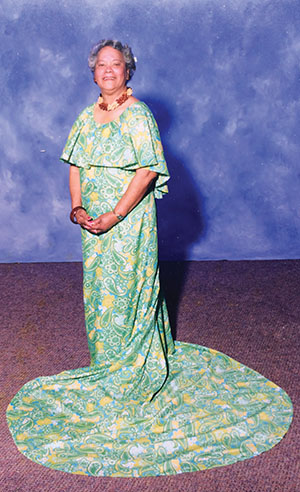
Different etymologies for the name have been proposed. One says that the first women to wear the garment cried out “Holo!” (Run!), and then stopped and cried out, “Kū!” Supposedly indicating, “I can run and I can stop!” Why would a woman do such a thing when she can run and stop perfectly well in any of her garments?
Another proposed etymology is that the women would say “Holo!” when turning the wheel to make the sewing machine run, and “Kū!” when they stopped the machine. But the first holokū was sewn in 1820. Mention was made of the garment by that name (sans kahakō) in newspapers in the 1830s. Elias Howe made the prototype of the first practical home sewing machine in 1844. The first such machines to be used in Hawai‘i probably arrived in the 1850s, so this etymology is unlikely.
Reading the old newspapers, searching for the earliest use of the word “holokū” and various permutations, has led me to formulate the following hypothesis: The word is a contraction of “holo aku,” (travel away), which is precisely what the needle does in a simple running stitch. An 1857 newspaper uses the term “holoku hana” in reference to digging up onions. Using a digging stick or spade to harvest onions in friable soil would produce the same motion (albeit on a larger scale) as that of a needle in a running stitch.
Or perhaps (keeping the kahakō) the best answer invokes lex parsimoniae. “Holokū” means, “evenly plump, stout, symmetrical,” which could very well apply to the appearance of a woman dressed in the voluminous garment.
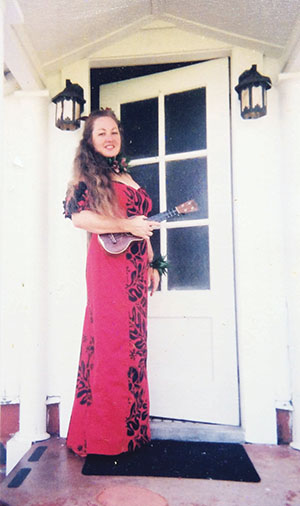
The upper classes tend to be the trendsetters, and the first to indulge in wearing the new holokū were royal women such as the chiefesses Kalākua, Kīna‘u, Keōpūolani, and Nāmāhāna. Originally very full, with gathers at the yoke and little in the way of shaping, it had the advantages of being cool and comfortable, and using great quantities of fabric—in keeping with the several layers of kapa a proper pā‘ū would comprise. Truly a status symbol worth wearing.
Undergarments also must be provided, and so a chemise must be sewn. Even simpler than the holokū, with no yoke, a shorter hem, and half-length sleeves, it was “mu‘umu‘u” —cut off. Comfortable and easier to work in, the mu‘umu‘u gained in popularity and became a popular garment for working, swimming, and lounging, especially among the common folk.
In the following decades, because of the affinity the Hawaiian royalty had for Great Britain, the fashion of Queen Victoria’s court had a strong influence on the development of upper crust Hawaiian fashion sensibilities. Hawaiian women subjected themselves to the corseted lacing and shaping that European women underwent. Even the holokū underwent a few pin tucks and some shaping. The train grew longer. Soon, public attire for the upscale was no different than for those of the same class in Europe. Toward the end of the 19th Century, the Crown Princess Ka‘iulani exemplified the height of Hawaiian fashion sense, and wore the new Edwardian styles with grace and charm. Through it all, the holokū and the mu‘umu‘u remained relaxing refuges for family times and informal occasions.
Then everything changed. Or, from a sartorial perspective, everything stopped changing
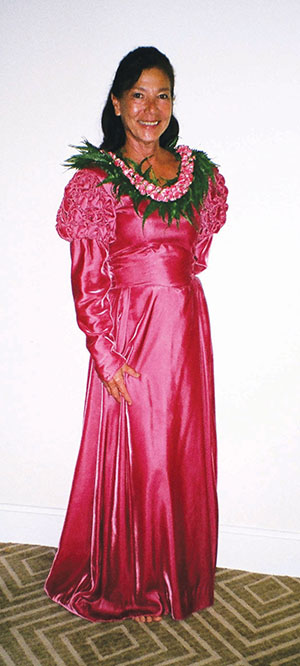
With the 1893 overthrow of the Hawaiian Monarchy, the 1898 annexation to the United States, and the 1899 death of the beloved Crown Princess Ka‘iulani, the Hawaiian people felt a loss that cut to the innermost heart of being. The holokū, once worn by royalty while relaxing on palace grounds, hand feeding peacocks, and entertaining close friends from half a world away, became a symbol of all that was now gone.
As day broke on the new century, night fell on the Hawaiian Kingdom.
The Americans and others who moved to, lived in, or visited the new island territory of the United States were enchanted with the ease and comfort of the mu‘umu‘u, now made in bright colors and floral prints. They took the former chemise home to California and Iowa, New England and Florida, and points around the world, and it came to define, for non-Hawaiians, “real” Hawaiian dress. And yet, in the islands themselves, the holokū clothed the self-image of Hawaiian women. Preserved like the petals of a cherished blossom, the traditional holokū remained the same.
At the turn of the century, the heavily boned and laced Victorian and Edwardian silhouettes stayed in the century that created them. The softer silhouette of the holokū, like a misty shadow of the elegance of that bygone time, still appears.
After World War I, the holokū developed two distinct categories: The traditional gown, by now often called the “Mother Hubbard,” remained, and a more fitted and embellished garment which was strongly influenced by the European tea gown began to appear. Lighter fabrics, straighter silhouettes, longer trains, laces, pin tucks, flounces, gores, and ruffles at the yoke, sleeve, and hem were experimented with, though for evening wear, heavy satins and velvets often were chosen. Called the “fashion holokū” by researcher Linda Boynton Arthur, this version of the garment became a showpiece of the designer’s art. As World War II approached, the gown began to incorporate bias cuts, princess lines, and side zippers.
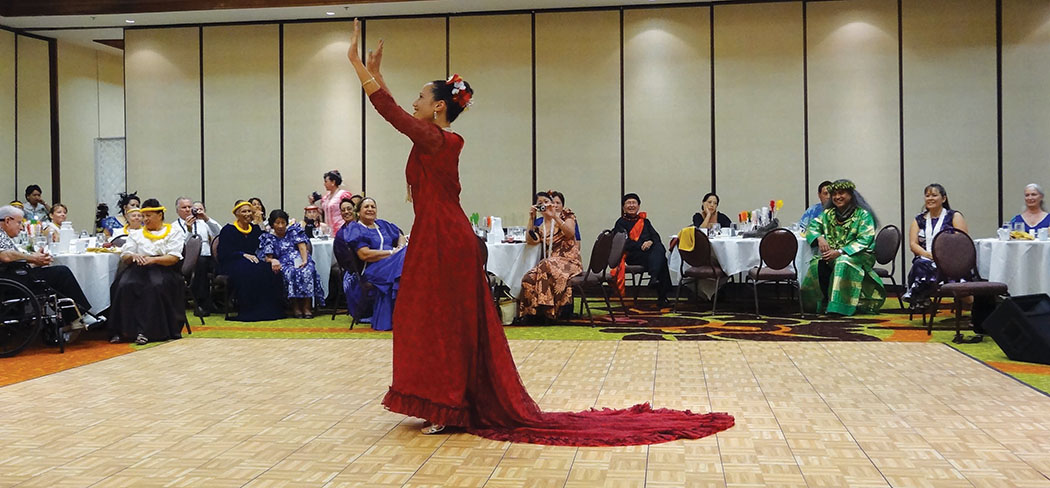
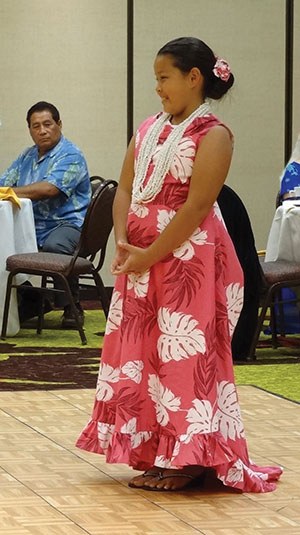
During and after WWII, bold “Hawaiian” tropical prints became popular as the fashion holokū became the garment of choice for solo hula dancers who needed to show up well on stage. Brilliant colors and bold designs were popular into the 1970s. Necklines dropped and trains lengthened. The ruffle evolved to look like a lei. Those of this cut which had the train eliminated were termed “holomu‘u.”
In the 1970s, with the Hawaiian Cultural Renaissance, fashion holokū design looked back to its roots. Though retaining the slimmer silhouette, colors became more reserved, necklines rose, and the yoke returned. Ruffles shrank to become an enhancement rather than a feature. Formal dress fabrics such as satin, brocade, lace, silk, and velvet are popular. One style incorporates a satin chemise over which a lace holokū in matching or contrasting color is worn. Since the 1980s, trains have become quite short, often remembered more in the gored style of the back than the actual length of the train.
Now touching three centuries, the traditional holokū remains essentially the same. Sometimes its outlines are sharply defined. At other times it is a faint shadow seen from the corner of the eye. But it remains. Clothing the spirits of Kalākua, Keōpūolani, Kīna‘u, Nāmāhāna, and Kapi‘olani, when we wear it today, we walk in their footsteps.
The holokū of the 21st century may be fitted or loose, off the shoulder or with a high-necked yoke, be fashioned from simple cotton or heavy brocade. It may be simple or elaborate. The train may be long or short. And it always echoes that dress first worn by Hawai‘i’s queens.
In whatever permutations it appears, there is something about a holokū that tells you immediately what it is. Like kī hō‘alu, distinctive music of our islands, it’s hard to define, and you know it when you hear it. The holokū is distinctly Hawaiian. ❖

Contact writer Leilehua Yuen: Leilehua@LeiManu.com
Resources
Newspapers
Ka Elele, 26 Aug 1848
Ka Hae Hawai‘i, 19 Dec 1856
Ka Hae Hawai‘i, 1 Jul 1857
Ka Hae Hawai‘i, 2 May 1860
Ka Hae Hawai‘i, 10 Oct 1860
Ka Hoku o ka Pakipika, 28 Nov 1861
Ke Kumu Hawai‘i, 1 Feb 1837
Nupepa Kuokoa, 12 Jul 1862
Nupepa Kuokoa, 22 Jul 1865
Nupepa Kuokoa, 9 Jun 1866
Nupepa Kuokoa, 23 Feb 1867
Manuscripts
Arthur, Linda Boynton; Fossilized Fashion in Hawai‘i; Washington State University
Books
Grimshaw, Patricia; New England Missionary Wives, Hawaiian Women, and the “Cult of True Womanhood”; University of Hawai‘i at Manoa.
Robert, Dana Lee; American Women in Mission: A Social History of Their Thought and Practice; Mercer University Press.
